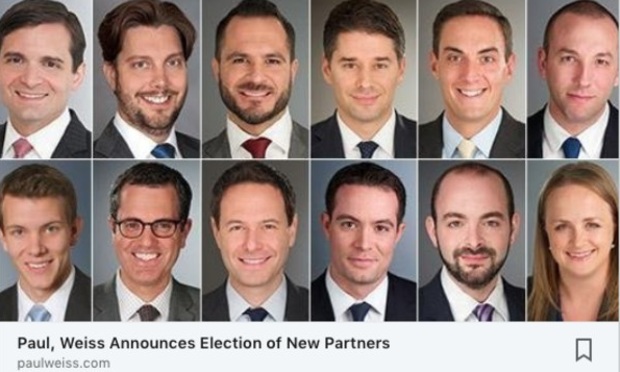Paul Weiss, Partner Promotions and the Path to Diversity in Big Law
The response to the firm's mostly white, mostly male partnership announcement provides an opportunity to move toward action on diversity.
January 03, 2019 at 03:24 PM
7 minute read
 The Paul Weiss LinkedIn posting announcing new partners. (Via LinkedIn)
The Paul Weiss LinkedIn posting announcing new partners. (Via LinkedIn)
Law firm partnership announcements provide an opportunity to convey multiple messages. They offer words of congratulations to those who have achieved a hard-earned milestone and showcase a firm's talent pool to key constituencies.
Another unintended message emerges when photos of the new partners reinforce a lack of diversity in the higher echelons of the profession—hardly a new story, but never a welcome one. We now know well the glacially slow upward trend of women at the lower partnership tiers, and far smaller gains, if any, for lawyers of color. Partnership announcements are an annual visual reminder of this failing.
Last month, Paul, Weiss, Rifkind, Wharton & Garrison announced that 12 associates would be elevated to partner status. Overall, it was a typical law firm press release that included the requisite head shots of the promoted associates.
The photo showed six white men on the top row and five on the bottom, followed by a single white woman whose placement was simply due to a last name that began with a letter near the end of the alphabet. The negative publicity that ensued focused on the impact of the images—stark in the lack of diversity, made even more obvious by the placement of the lone woman at the end.
In an apparent response to the negative press, the firm's chair announced a town hall meeting to be held in January to discuss “diversity” and “associate professional satisfaction.” And, yes, the email included the unfortunate quotation marks around those words.
Paul Weiss deserves credit for responding to the negative feedback by engaging in an internal public conversation. It is also important that the fallout from the firm's partnership announcement not diminish the accomplishments of the 12 promoted associates.
But a conversation cannot erase what the announcement revealed. No matter how attuned to culture and values a firm claims to be, a partnership class of 11 white men and one white woman is a visible reminder that merely stating a commitment to culture and values is not sufficient.
These new partners started out in much larger associate classes. Along the way, the firm should have noticed that men were advancing and women were not, and taken steps to intervene. The same can be said, of course, about most large law firms today.
Whether the firm's town hall is successful will depend, in large measure, on what has been learned from this experience. Law firms have been talking about “diversity” and “associate professional satisfaction” for decades. The reason why more has not been accomplished is that firms tend to implement the easier measures, rather than the difficult ones involving metrics and accountability. Meaningful cultural and demographic changes, however, require partners to commit to more complex actions.
For a truly successful town hall meeting, the following are key issues that the firm should be prepared to address:
- What specific metrics are considered in partnership elevation? Do these metrics align with the firm's expressed commitment to diversity? Does the firm's compensation and bonus structure value those who demonstrate institutional commitment through participation in committees and activities such as mentoring, associate hiring and training, and diversity and inclusion, or are those considered office housework that often carry an economic penalty rather than a reward? Is compensation a factor in holding leaders accountable for successful implementation of firm diversity initiatives? As another example, does the firm analyze retention by practice group or office location to determine whether attrition is driven by negative conduct, and does it respond accordingly through compensation?
- What is the annual budget for each affinity group and related diversity initiative, and do diversity professionals report directly to the firm's chair? Diversity initiatives are often featured prominently on websites, without a concomitant level of prominence within a firm's hierarchy. NAWL Foundation data has shown that the average budget of a women's initiative is less than the cost of a first-year associate. Yet budgets and reporting lines are the clearest reflection of an organization's priorities. If the profession is ever going to move beyond the decades-old data showing that women and lawyers of color are paid less, promoted less, and leave more often, then diversity and inclusion will need to be fully integrated into the firm's strategic goals, with budgets and reporting structures that reflect their importance.
- Does the firm regularly follow key research on and provide training about workplace issues such as harassment, bullying and other negative behaviors that deplete morale and drive attrition? Is annual unconscious bias training required for all personnel? Strong leadership requires self-awareness and an understanding of the many cognitive biases that stand in the way of effective stewardship. Are attribution biases resulting in a tendency to take responsibility for success, while blaming failure on external factors? Are decisions based on information that confirms pre-existing beliefs and excludes contradictory evidence, thereby promoting confirmation bias? Are unconscious biases impacting the way those who are different are assigned work and evaluated? These are critical areas that warrant individual and firm attention and resources.
- What has the firm learned from its clients and other business models about improving talent management and development? Do practice group leaders assume responsibility for nurturing and developing tomorrow's partners and rainmakers by, for example, providing the time and attention needed to mentor young talent, help resolve billing credit disputes among colleagues, and ensure work is assigned equitably?
- How does the firm distribute work and related origination credit from longstanding clients after a partner retires or leaves to ensure it is allocated equitably, and not simply bequeathed to favored associates? The single biggest metric that impedes the advancement and equitable compensation of women and minorities in law firms is business development credit, yet few firms differentiate between the credits allocated to lawyers based on “inherited” client work versus development of new clients.
- What specifically is being done to address the demographic shifts taking place in the workplace? Does the firm ignore the stereotypes about millennials and focus on characteristics supported by data, such as the generation's concerns about work-life integration and alternative work arrangements that focus on flexibility? Similarly, do maternity, paternity and alternative work arrangements apply equally to men and women, without stigma?
- Does the firm engage all generations in developing its strategic vision within each area of practice? As young lawyers seek to influence their work environment, all practice groups would benefit from teaming the skills and views of millennials with the wisdom, experience and perspective of Gen X and Boomer lawyers. Such multigenerational engagement can break down internal barriers to business development and succession, and offer ideas for a workplace that will retain young lawyers, including diverse associates, for the long-term.
Paul Weiss leaders have a unique opportunity at the firm's town hall. They can move the dialogue about “diversity” and “associate professional satisfaction” beyond a conversation designated by quotation marks, and develop a roadmap to ensure that diversity and inclusion are key strategic initiatives central to all aspects of the firm's goals, plans and compensation and promotion structures. By doing so, future partnership announcements can be met solely with congratulations for a job well done.
Lauren Stiller Rikleen, president of the Rikleen Institute for Strategic Leadership, is the author of “You Raised Us, Now Work With Us: Millennials, Career Success, and Building Strong Workplace Teams.” Her newest book, “The Shield of Silence: How Power Perpetuates a Culture of Harassment and Bullying in the Workplace,” will be released in May.
This content has been archived. It is available through our partners, LexisNexis® and Bloomberg Law.
To view this content, please continue to their sites.
Not a Lexis Subscriber?
Subscribe Now
Not a Bloomberg Law Subscriber?
Subscribe Now
NOT FOR REPRINT
© 2025 ALM Global, LLC, All Rights Reserved. Request academic re-use from www.copyright.com. All other uses, submit a request to [email protected]. For more information visit Asset & Logo Licensing.
You Might Like
View All
Change Is Coming With the New Trump Era. For Big Law, Change Is Already Here
6 minute read


Letter From London: 5 Predictions for Big Law in 2025, Plus 5 More Risky Ones
6 minute readTrending Stories
Who Got The Work
J. Brugh Lower of Gibbons has entered an appearance for industrial equipment supplier Devco Corporation in a pending trademark infringement lawsuit. The suit, accusing the defendant of selling knock-off Graco products, was filed Dec. 18 in New Jersey District Court by Rivkin Radler on behalf of Graco Inc. and Graco Minnesota. The case, assigned to U.S. District Judge Zahid N. Quraishi, is 3:24-cv-11294, Graco Inc. et al v. Devco Corporation.
Who Got The Work
Rebecca Maller-Stein and Kent A. Yalowitz of Arnold & Porter Kaye Scholer have entered their appearances for Hanaco Venture Capital and its executives, Lior Prosor and David Frankel, in a pending securities lawsuit. The action, filed on Dec. 24 in New York Southern District Court by Zell, Aron & Co. on behalf of Goldeneye Advisors, accuses the defendants of negligently and fraudulently managing the plaintiff's $1 million investment. The case, assigned to U.S. District Judge Vernon S. Broderick, is 1:24-cv-09918, Goldeneye Advisors, LLC v. Hanaco Venture Capital, Ltd. et al.
Who Got The Work
Attorneys from A&O Shearman has stepped in as defense counsel for Toronto-Dominion Bank and other defendants in a pending securities class action. The suit, filed Dec. 11 in New York Southern District Court by Bleichmar Fonti & Auld, accuses the defendants of concealing the bank's 'pervasive' deficiencies in regards to its compliance with the Bank Secrecy Act and the quality of its anti-money laundering controls. The case, assigned to U.S. District Judge Arun Subramanian, is 1:24-cv-09445, Gonzalez v. The Toronto-Dominion Bank et al.
Who Got The Work
Crown Castle International, a Pennsylvania company providing shared communications infrastructure, has turned to Luke D. Wolf of Gordon Rees Scully Mansukhani to fend off a pending breach-of-contract lawsuit. The court action, filed Nov. 25 in Michigan Eastern District Court by Hooper Hathaway PC on behalf of The Town Residences LLC, accuses Crown Castle of failing to transfer approximately $30,000 in utility payments from T-Mobile in breach of a roof-top lease and assignment agreement. The case, assigned to U.S. District Judge Susan K. Declercq, is 2:24-cv-13131, The Town Residences LLC v. T-Mobile US, Inc. et al.
Who Got The Work
Wilfred P. Coronato and Daniel M. Schwartz of McCarter & English have stepped in as defense counsel to Electrolux Home Products Inc. in a pending product liability lawsuit. The court action, filed Nov. 26 in New York Eastern District Court by Poulos Lopiccolo PC and Nagel Rice LLP on behalf of David Stern, alleges that the defendant's refrigerators’ drawers and shelving repeatedly break and fall apart within months after purchase. The case, assigned to U.S. District Judge Joan M. Azrack, is 2:24-cv-08204, Stern v. Electrolux Home Products, Inc.
Featured Firms
Law Offices of Gary Martin Hays & Associates, P.C.
(470) 294-1674
Law Offices of Mark E. Salomone
(857) 444-6468
Smith & Hassler
(713) 739-1250










